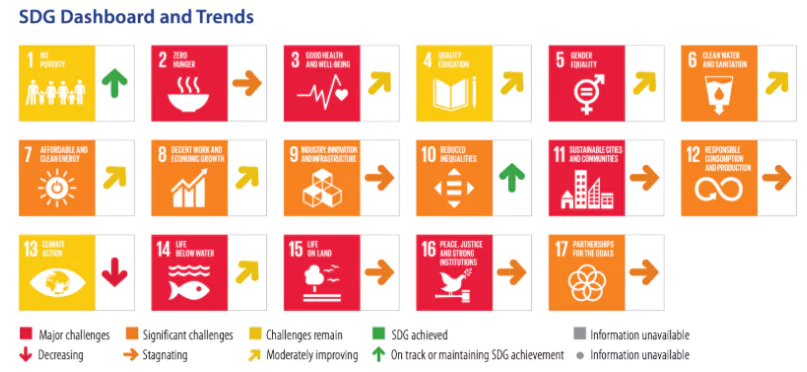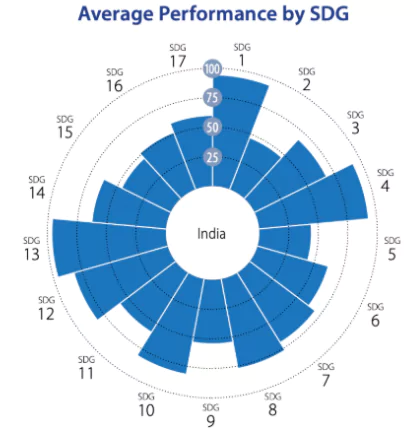India has entered the top 100 in the Sustainable Development Goals (SDG) Index published by Sustainable Development Solutions Network (SDSN).
About Sustainable Development Goals (SDGs)
- SDGs are the blueprint to achieve a better and more sustainable future for all.
- They are a set of 17 global goals adopted by all United Nations (UN)member states in 2015. designed to end poverty, protect the planet, and ensure peace and prosperity by 2030.
- These goals address a wide range of social, economic, and environmental challenges, aiming to create a sustainable future for all.
- Each goal is comprehensive and interconnected, focusing on key areas like health, education, economic growth, environmental protection, and climate action.
|
Sustainable Development Solutions Network (SDSN)
- Established in 2012 by Ban Ki-Moon and economist Jeffrey Sachs under the UN Secretary-General’s auspices.
- It works under the UN Secretary-General.
- It promotes achieving the Sustainable Development Goals (SDGs) and the Paris Agreement through education, research, policy analysis, and global cooperation.
- Publication: Since 2016, SDSN has published a Sustainable Development Report each year that reviews the progress of the 193 UN Member States on the Sustainable Development Goals (SDGs).
- Focuses on evidence-based policy, global cooperation, and accountability for sustainable development.
|
Key Highlights of the Report
Global Highlights
- Only 17% of SDG targets are on track to be achieved by 2030, with 83% showing limited or reversed progress.
- Global progress has stalled since 2020, especially for SDG 2 (Zero Hunger), SDG 14 (Life Below Water), SDG 15 (Life on Land), SDG 16 (Peace, Justice, and Strong Institutions).
- Brazil leads among G20 nations; Chile leads among OECD countries.
- The U.S. ranks last (193rd) after withdrawing from key global agreements and opposing the SDGs.
- Barbados ranks #1 for commitment to UN multilateralism, followed by Jamaica and Trinidad and Tobago.
Progress: Despite global setbacks, notable progress is seen in basic services and infrastructure:
- Mobile broadband use (SDG 9)
- Internet access (SDG 9)
- Electricity access (SDG 7)
- Reduction in under-five and neonatal mortality (SDG 3)
Decline: Five indicators have reversed since 2015:
- Obesity rate (SDG 2)
- Press freedom (SDG 16)
- Nitrogen management (SDG 2)
- Red List Index (SDG 15)
- Corruption Perceptions Index (SDG 16)
Uneven Progress
- Finland ranks #1, followed by Sweden and Denmark.
- 19 of the top 20 countries are from Europe.
- However, even these countries face challenges in climate and biodiversity goals due to unsustainable consumption.
- East and South Asia has seen the fastest regional SDG progress since 2015, driven by socioeconomic development.
- Fastest-improving countries (since 2015, by SDG Index score increase):
- Nepal, Cambodia, Philippines, Bangladesh, Mongolia
- Benin, Peru, UAE, Uzbekistan, Costa Rica, Saudi Arabia are the other countries showing rapid progress among their peers
Financial architecture
- The global financial system is misaligned – it favors capital flows to wealthy nations while starving emerging and developing economies (EMDEs) of needed investment.
Performance of India in the SDG Index
- India ranks 99th in the 2025 SDG Index, entering the top 100 for the first time, with a score of 67.0.
- Progress attributed to improved access to Electricity (SDG 7), Internet and mobile broadband (SDG 9), Reduction in under-five and neonatal mortality (SDG 3)

- Despite gains, India (like many countries) still faces challenges in biodiversity, sustainable agriculture, and climate action.
Regional comparison:
- China: 49th (74.4)
- Maldives: 53rd (74.0)
- Bhutan: 74th (70.5)
- Nepal: 85th (68.6)
- Sri Lanka: 93rd (67.9)
- Bangladesh: 114th (63.9)
- Pakistan: 140th (57.0)
|

![]() 24 Jun 2025
24 Jun 2025



